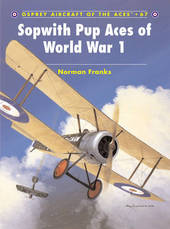
|
Sopwith Pup Aces of World War 1
Paperback / softback
Main Details
| Title |
Sopwith Pup Aces of World War 1
|
| Authors and Contributors |
By (author) Norman Franks
|
|
Illustrated by Harry Dempsey
|
| Series | Aircraft of the Aces |
|---|
| Physical Properties |
| Format:Paperback / softback | | Pages:96 | | Dimensions(mm): Height 248,Width 184 |
|
| Category/Genre | First world war |
|---|
| ISBN/Barcode |
9781841768861
|
| Classifications | Dewey:940.44941 |
|---|
| Audience | | General | | Further/Higher Education | | Undergraduate | |
|---|
| Illustrations |
98 b/w; 32 col
|
|
Publishing Details |
| Publisher |
Bloomsbury Publishing PLC
|
| Imprint |
Osprey Publishing
|
| Publication Date |
6 July 2005 |
| Publication Country |
United Kingdom
|
Description
The Sopwith Pup was the forerunner of the hugely successful Sopwith Camel, which duly became the most successful fighter of World War 1. The first proper British fighting scout, the first Pups - the Royal Naval Air Service - arrived on the Western Front in 1916. Although regarded as a 'nice' aeroplane to fly, pilots who used it in combat gained much success during the first half of 1917. The Royal Flying Corps also used the Pup from January 1917 onwards, with the final combats with the machine occurring in December of that year. This book describes the combat careers of the successful Pup aces, how they flew and how they fought.
Author Biography
Norman Franks lives in East Sussex and is a recognised authority on both World War 1 and World War 2 aviation history. With around 80 published works on his subject, he has written many titles for Osprey. Harry Dempsey has been passionate about World War 1 aviation for over 30 years and has produced the most technically accurate artwork on the subject. He has illustrated all the World War 1 titles for Osprey's Aircraft of the Aces series to date. He lives in Buckinghamshire, UK.
Reviews"I have reviewed a few of the Osprey 'Aces of...' titles and found this book to be of the same high quality as the rest of the series. The photography and color plates are outstanding... Overall, this is an excellent book, and I highly recommend it." --Rob Auer, Proceedings
|